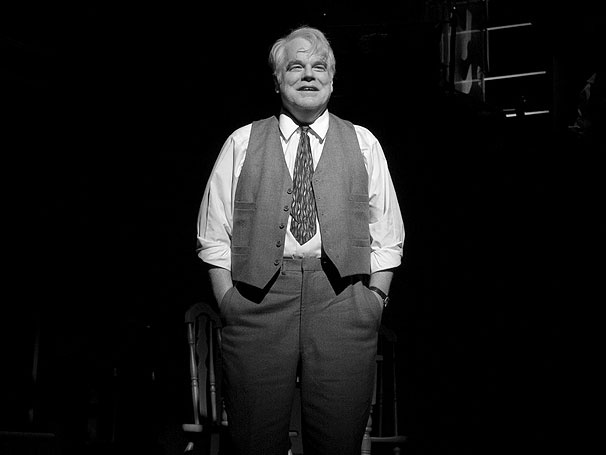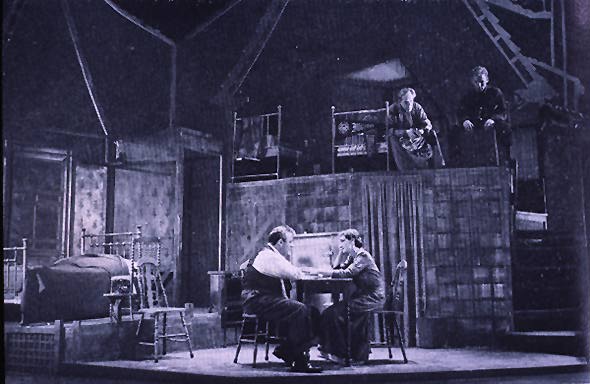I shall have more to say when I am dead.
Edwin Arlington Robinson, “John Brown”
TT: Some final thoughts on Mike Daisey
Apropos of my earlier posting on Mike Daisey and The Agony and the Ecstasy of Steve Jobs, a footnote:
I don’t think Daisey’s exposure as a fabricator is an occasion for schadenfreude. He is a greatly gifted theater artist, and The Agony and the Ecstasy of Steve Jobs, as Ira Glass and Rob Schmitz readily acknowledge in the latest episode of This American Life, was mostly true.
Be that as it may, the fact remains that Daisey claimed in his show to have seen things in China that he did not see, and used his hard-earned credibility as an artist to persuade his audiences that he had seen them–and that, I regret to say, is unforgivable.
PLAY
Saint Joan (Access, 380 Broadway, reopening Apr. 24-May 13). George Bernard Shaw’s history play about Joan of Arc runs for three and a half hours and calls for a pageant-sized cast of twenty-four. How to make it doable in a tiny off-off-Broadway theater? By reconfiguring the script for a woman and three men who switch from part to part à la The 39 Steps. It may sound gimmicky, but Eric Tucker’s vest-pocket staging, mounted in a house so small that one scene is played in the lobby, fuses Shakespearean speed with Brechtian directness. It’s the most exciting Shaw revival I’ve ever seen (TT).
TT: About Mike Daisey and Steve Jobs
 This American Life ran an episode about Mike Daisey’s The Agony and the Ecstasy of Steve Jobs in January. Today TAL announced that Daisey’s account of how Apple products are made was “partially fabricated” and that it was “retracting” the episode. The next episode of TAL will be devoted to “detailing the errors” in “Mr. Daisey Goes to the Apple Factory.” Says Ira Glass: “We’ll be posting the audio of the program and the transcript on Friday night this week, instead of waiting till Sunday.”
This American Life ran an episode about Mike Daisey’s The Agony and the Ecstasy of Steve Jobs in January. Today TAL announced that Daisey’s account of how Apple products are made was “partially fabricated” and that it was “retracting” the episode. The next episode of TAL will be devoted to “detailing the errors” in “Mr. Daisey Goes to the Apple Factory.” Says Ira Glass: “We’ll be posting the audio of the program and the transcript on Friday night this week, instead of waiting till Sunday.”
The TAL announcement, which describes the fabrications, is here.
Rob Schmitz, who checked out the story and discovered the fabrications, discusses them in detail here.
Here is a complete transcript of “Retraction,” the latest episode of This American Life, in which Ira Glass and Rob Schmitz interview Mike Daisey about how and why he misrepresented the facts in The Agony and the Ecstasy of Steve Jobs.
The Wall Street Journal story on the retraction is here.
Says Daisey on his blog:
I stand by my work. My show is a theatrical piece whose goal is to create a human connection between our gorgeous devices and the brutal circumstances from which they emerge. It uses a combination of fact, memoir, and dramatic license to tell its story, and I believe it does so with integrity. Certainly, the comprehensive investigations undertaken by The New York Times and a number of labor rights groups to document conditions in electronics manufacturing would seem to bear this out.
What I do is not journalism. The tools of the theater are not the same as the tools of journalism. For this reason, I regret that I allowed THIS AMERICAN LIFE to air an excerpt from my monologue. THIS AMERICAN LIFE is essentially a journalistic–not a theatrical–enterprise, and as such it operates under a different set of rules and expectations. But this is my only regret. I am proud that my work seems to have sparked a growing storm of attention and concern over the often appalling conditions under which many of the high-tech products we love so much are assembled in China.
For the record, I broached the possibility that Mike Daisey might have been fudging the facts in my original Wall Street Journal review of The Agony and the Ecstasy of Steve Jobs, published last October.
Here’s what I wrote:
Mr. Daisey’s new monologue is first and foremost a work of theatrical art, just as Mr. Daisey himself, though he is not an actor in the ordinary sense of the word, is an awesomely gifted stage performer. Indeed, it is so strong a piece of theater that you can’t help but wonder about its journalistic soundness….
The trouble with “The Agony and the Ecstasy of Steve Jobs,” as with all theatrical journalism, is that Mr. Daisey is in essence asking us to take his word for it. He hasn’t brought back pictures or named names, and the artful anger with which he tells his tale inevitably makes it still more suspect. You don’t have to be a puritan to prefer that facts be served straight up.
I’ll have more to say about all this a little later in the evening.
UPDATE: Mark Kennedy’s Associated Press story about the Daisey scandal.
An audio recording of the new prologue added by Daisey to Saturday’s performance of The Agony and the Ecstasy of Steve Jobs. (Daisey posted this recording on his blog.)
Josh Ong of AppleInsider summarizes the scandal to date.
* * *
Here are my own final thoughts on Mike Daisey.
SOMETIMES IN THE ARTS, IMPERMANENCE IS GOOD
“Yes, it’s sad–tragic, really–that great theatrical experiences are destined to fade from memory. But I also know that it is because of the inexorable perishability of such productions that younger performers, directors and designers are able to reimagine the classics in ways that make visual and emotional sense to successive generations of audiences…”
TT: A smile, a shoeshine, and a saint
In today’s Wall Street Journal drama column I review Mike Nichols’ Broadway revival of Arthur Miller’s Death of a Salesman and an off-off-Broadway revival of George Bernard Shaw’s Saint Joan. Both are memorable–equally so. Here’s an excerpt.
* * *
 Willy Loman is back on Broadway–for the fifth time. Philip Seymour Hoffman, the star of Mike Nichols’ revival of Arthur Miller’s “Death of a Salesman,” is following in the well-remembered footsteps of Lee J. Cobb, George C. Scott, Dustin Hoffman and Brian Dennehy, and it’s a tribute to his talent that you won’t feel inclined to compare him to any of his predecessors. When he first comes trudging onto the stage, carrying his weatherbeaten sample cases as though each one contains half the weight of the world, you feel at once that you’re seeing not a performance but a person, stooped and stunned by the burden of failure….
Willy Loman is back on Broadway–for the fifth time. Philip Seymour Hoffman, the star of Mike Nichols’ revival of Arthur Miller’s “Death of a Salesman,” is following in the well-remembered footsteps of Lee J. Cobb, George C. Scott, Dustin Hoffman and Brian Dennehy, and it’s a tribute to his talent that you won’t feel inclined to compare him to any of his predecessors. When he first comes trudging onto the stage, carrying his weatherbeaten sample cases as though each one contains half the weight of the world, you feel at once that you’re seeing not a performance but a person, stooped and stunned by the burden of failure….
The genius of Mr. Nichols’ unostentatiously right staging of “Death of a Salesman” is that each part of it is in harmony with Mr. Hoffman’s plain, blunt acting. Like his star–and the rest of his perfectly chosen cast–Mr. Nichols has disappeared into the play itself. The result is is a production that will be remembered by all who see it as the capstone of a career.
Linda Emond, who plays Willy’s weary but loyal wife, isn’t as famous as Mr. Hoffman, but she’s just as good, maybe even better. Here as in Tony Kushner’s “Intelligent Homosexual’s Guide to Capitalism and Socialism with a Key to the Scriptures,” in which she appeared last spring, everything that Ms. Emond does and says is starkly true to life. The only reason why she doesn’t stand out more decisively is that much the same thing could be said of the other members of the cast, in particular Andrew Garfield as Biff Loman and Bill Camp as Charley, Willy’s best friend. To praise one is to disserve the rest: All are as real as a cup of grocery-store coffee served in a chipped mug….
 If, like the Lomans, you’re strapped for cash, rest assured that you needn’t pay Broadway prices to catch an unforgettable show. Bedlam’s Off-Off-Broadway version of “Saint Joan,” for instance, is the most exciting George Bernard Shaw revival I’ve ever seen, bar none.
If, like the Lomans, you’re strapped for cash, rest assured that you needn’t pay Broadway prices to catch an unforgettable show. Bedlam’s Off-Off-Broadway version of “Saint Joan,” for instance, is the most exciting George Bernard Shaw revival I’ve ever seen, bar none.
Shaw’s 1923 play, in which he turned the story of Joan of Arc into an incisive portrait of an idealistic tomboy who pits herself against a group of worldly, well-meaning clerics who end up doing the wrong thing for the right reasons, is rarely performed in America. Why? Because it runs for three and a half hours and calls for a pageant-sized cast of 24. Enter Eric Tucker, who has reconfigured the script for a woman (Andrus Nichols) and three men (Ted Lewis, Tom O’Keefe and Mr. Tucker himself) who switch from part to part à la “The 39 Steps.” It may sound gimmicky, but Mr. Tucker’s vest-pocket staging, mounted in a house so small that one scene is played in the lobby, fuses Shakespearean speed with Brechtian directness….
* * *
Read the whole thing here.
TT: The ghost of Jo Mielziner
My “Sightings” column in today’s Wall Street Journal, like my drama column, is occasioned by the new Broadway revival of Death of a Salesman. Here’s an excerpt.
* * *
George Balanchine, the greatest choreographer of the 20th century, believed that all ballets, even his, were like butterflies: “A breath, a memory, then gone.” Twenty-nine years after his death, Balanchine’s ballets continue to be performed throughout the world, but it’s also true that the way in which they are danced today is not the way in which they were danced when Balanchine himself was around to rehearse them. The steps may be the same, but the nuances are different–sometimes joltingly so…
What is true of ballet is no less true of the other lively arts. Change is built into their natures. You watch a performance and then…it’s gone. All that work, all that passion, all that dedication, and when it’s over, it’s over, leaving nothing but memories–and, if you’re lucky, a recording that can serve as a souvenir, however imperfect, of the experience.
 To be sure, great theatrical performances of the past leave behind a different kind of souvenir, which is their décor. Mike Nichols’ production of Arthur Miller’s “Death of a Salesman,” which opened on Broadway this week, is being performed on a reproduction of the set that was created by Jo Mielziner, America’s most admired and innovative theatrical set designer, for the play’s original 1949 production, and it also makes use of the incidental music composed by Alex North for the same production. Mr. Nichols, who saw “Death of a Salesman” performed on Broadway when he was 17 years old, never forgot the impression made on him by Mielziner’s skeletal set and North’s fragile, wistful score, and so he decided to incorporate them into his own staging 63 years later….
To be sure, great theatrical performances of the past leave behind a different kind of souvenir, which is their décor. Mike Nichols’ production of Arthur Miller’s “Death of a Salesman,” which opened on Broadway this week, is being performed on a reproduction of the set that was created by Jo Mielziner, America’s most admired and innovative theatrical set designer, for the play’s original 1949 production, and it also makes use of the incidental music composed by Alex North for the same production. Mr. Nichols, who saw “Death of a Salesman” performed on Broadway when he was 17 years old, never forgot the impression made on him by Mielziner’s skeletal set and North’s fragile, wistful score, and so he decided to incorporate them into his own staging 63 years later….
Such exhumations are not unprecedented. The New York City Ballet still dances Balanchine’s “Prodigal Son” in front of faithful reproductions of the backdrops that were painted by the French artist Georges Rouault for the 1929 Ballets Russes premiere….
Even so, it is rare for anyone to try to “revive” any aspect of a historically significant theatrical performance, even one as durable as its décor….
* * *
Read the whole thing here.
TT: Almanac
“A mother is not a person to lean on but a person to make leaning unnecessary.”
Dorothy Canfield Fisher, Her Son’s Wife
